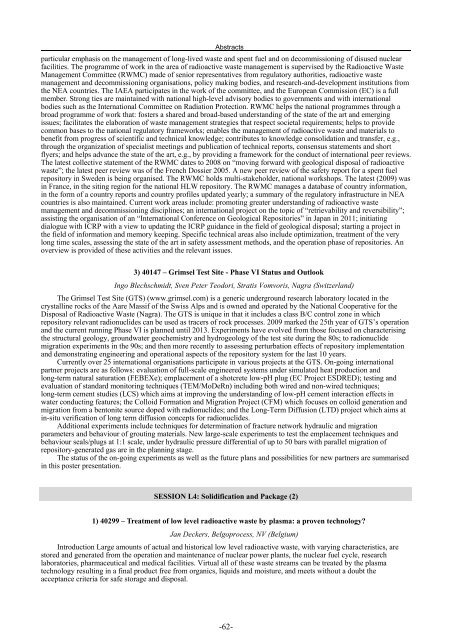ASME Message
ASME Message
ASME Message
Create successful ePaper yourself
Turn your PDF publications into a flip-book with our unique Google optimized e-Paper software.
Abstracts<br />
particular emphasis on the management of long-lived waste and spent fuel and on decommissioning of disused nuclear<br />
facilities. The programme of work in the area of radioactive waste management is supervised by the Radioactive Waste<br />
Management Committee (RWMC) made of senior representatives from regulatory authorities, radioactive waste<br />
management and decommissioning organisations, policy making bodies, and research-and-development institutions from<br />
the NEA countries. The IAEA participates in the work of the committee, and the European Commission (EC) is a full<br />
member. Strong ties are maintained with national high-level advisory bodies to governments and with international<br />
bodies such as the International Committee on Radiation Protection. RWMC helps the national programmes through a<br />
broad programme of work that: fosters a shared and broad-based understanding of the state of the art and emerging<br />
issues; facilitates the elaboration of waste management strategies that respect societal requirements; helps to provide<br />
common bases to the national regulatory frameworks; enables the management of radioactive waste and materials to<br />
benefit from progress of scientific and technical knowledge; contributes to knowledge consolidation and transfer, e.g.,<br />
through the organization of specialist meetings and publication of technical reports, consensus statements and short<br />
flyers; and helps advance the state of the art, e.g., by providing a framework for the conduct of international peer reviews.<br />
The latest collective statement of the RWMC dates to 2008 on “moving forward with geological disposal of radioactive<br />
waste”; the latest peer review was of the French Dossier 2005. A new peer review of the safety report for a spent fuel<br />
repository in Sweden is being organised. The RWMC holds multi-stakeholder, national workshops. The latest (2009) was<br />
in France, in the siting region for the national HLW repository. The RWMC manages a database of country information,<br />
in the form of a country reports and country profiles updated yearly; a summary of the regulatory infrastructure in NEA<br />
countries is also maintained. Current work areas include: promoting greater understanding of radioactive waste<br />
management and decommissioning disciplines; an international project on the topic of “retrievability and reversibility”;<br />
assisting the organisation of an “International Conference on Geological Repositories” in Japan in 2011; initiating<br />
dialogue with ICRP with a view to updating the ICRP guidance in the field of geological disposal; starting a project in<br />
the field of information and memory keeping. Specific technical areas also include optimization, treatment of the very<br />
long time scales, assessing the state of the art in safety assessment methods, and the operation phase of repositories. An<br />
overview is provided of these activities and the relevant issues.<br />
3) 40147 – Grimsel Test Site - Phase VI Status and Outlook<br />
Ingo Blechschmidt, Sven Peter Teodori, Stratis Vomvoris, Nagra (Switzerland)<br />
The Grimsel Test Site (GTS) (www.grimsel.com) is a generic underground research laboratory located in the<br />
crystalline rocks of the Aare Massif of the Swiss Alps and is owned and operated by the National Cooperative for the<br />
Disposal of Radioactive Waste (Nagra). The GTS is unique in that it includes a class B/C control zone in which<br />
repository relevant radionuclides can be used as tracers of rock processes. 2009 marked the 25th year of GTS’s operation<br />
and the current running Phase VI is planned until 2013. Experiments have evolved from those focused on characterising<br />
the structural geology, groundwater geochemistry and hydrogeology of the test site during the 80s; to radionuclide<br />
migration experiments in the 90s; and then more recently to assessing perturbation effects of repository implementation<br />
and demonstrating engineering and operational aspects of the repository system for the last 10 years.<br />
Currently over 25 international organisations participate in various projects at the GTS. On-going international<br />
partner projects are as follows: evaluation of full-scale engineered systems under simulated heat production and<br />
long-term natural saturation (FEBEXe); emplacement of a shotcrete low-pH plug (EC Project ESDRED); testing and<br />
evaluation of standard monitoring techniques (TEM/MoDeRn) including both wired and non-wired techniques;<br />
long-term cement studies (LCS) which aims at improving the understanding of low-pH cement interaction effects in<br />
water conducting features; the Colloid Formation and Migration Project (CFM) which focuses on colloid generation and<br />
migration from a bentonite source doped with radionuclides; and the Long-Term Diffusion (LTD) project which aims at<br />
in-situ verification of long term diffusion concepts for radionuclides.<br />
Additional experiments include techniques for determination of fracture network hydraulic and migration<br />
parameters and behaviour of grouting materials. New large-scale experiments to test the emplacement techniques and<br />
behaviour seals/plugs at 1:1 scale, under hydraulic pressure differential of up to 50 bars with parallel migration of<br />
repository-generated gas are in the planning stage.<br />
The status of the on-going experiments as well as the future plans and possibilities for new partners are summarised<br />
in this poster presentation.<br />
SESSION L4: Solidification and Package (2)<br />
1) 40299 – Treatment of low level radioactive waste by plasma: a proven technology?<br />
Jan Deckers, Belgoprocess, NV (Belgium)<br />
Introduction Large amounts of actual and historical low level radioactive waste, with varying characteristics, are<br />
stored and generated from the operation and maintenance of nuclear power plants, the nuclear fuel cycle, research<br />
laboratories, pharmaceutical and medical facilities. Virtual all of these waste streams can be treated by the plasma<br />
technology resulting in a final product free from organics, liquids and moisture, and meets without a doubt the<br />
acceptance criteria for safe storage and disposal.<br />
-62-


